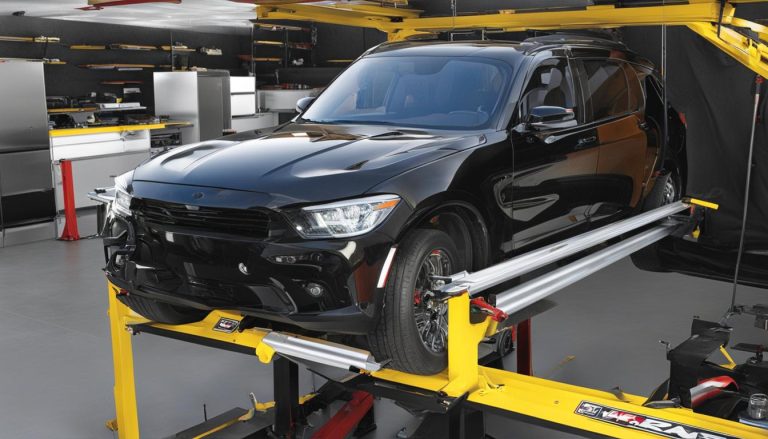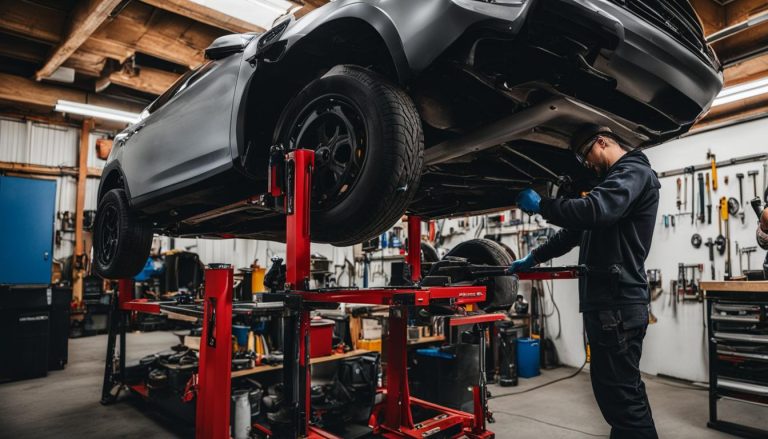Install Traction Bars on Leaf Springs Guide
Installing traction bars on leaf springs can greatly enhance your vehicle’s performance. By preventing spring wrap-up and limiting wheelhop, traction bars help keep your tires planted on the ground, resulting in improved traction and stability. In this guide, we will provide step-by-step instructions on how to install traction bars on leaf springs for a smooth and stable drive.
Key Takeaways:
- Installing traction bars on leaf springs improves traction and stability.
- Preventing spring wrap-up and limiting wheelhop enhances performance.
- Step-by-step instructions will guide you through the installation process.
- Proper positioning and alignment are crucial for effective traction bar functionality.
- Adjusting the snubber and clearance gap optimizes performance.
What You’ll Need for the Installation
Before you begin the leaf spring traction bar installation process, it’s essential to gather all the necessary tools and materials. Ensuring you have everything on hand will help facilitate a smooth and successful installation. Below is a list of items you’ll need:
- Safety jack stands
- U-bolts and mounting brackets
- Rubber snubber
- Hacksaw (for adjusting the snubber)
- Shims (for adjusting the bar angle)
- Wrenches and sockets
By having these tools and materials readily available, you’ll be well-prepared to install leaf spring traction bars for improved vehicle performance. Let’s dive into the installation process in the next section.
Preparation and Safety Measures
Prior to installing the traction bars, it’s crucial to take some preparatory steps and ensure your safety. Follow these steps:
- Lift the rear of the vehicle using a jack, making sure to block the front wheels and securely place safety jack stands under the rear end.
- Position the traction bar under the rear spring, ensuring adequate clearance for all suspension components.
- Secure the traction bar with U-bolts and tighten all nuts securely.
- Adjust the rubber snubber to the desired performance by cutting the top of the snubber with a hacksaw.
Installing traction bars on leaf springs requires careful preparation to ensure a successful installation. By following these safety measures and taking the necessary precautions, you can proceed with confidence and enjoy the benefits of improved traction and stability.
Positioning and Alignment
Proper positioning and alignment are essential for the effective functioning of leaf spring traction bars. By following these steps, you can ensure the optimal installation and alignment of your traction bars:
- Position the traction bar: Start by positioning the traction bar under the leaf spring. Make sure that the snubber end faces the front of the car. This will allow the traction bar to function properly.
- Center the mounting pad: Ensure that the traction bar mounting pad is centered under the axle and U-bolts. It is important to check that the leaf spring centering bolt/stud does not make contact with the traction bar, as this could affect its alignment and performance.
- Adjust the bar angle: To achieve optimal alignment, use shims on the rear mounting bracket to adjust the bar angle. The snubber end of the traction bar should be angled up parallel to the chassis, allowing for smoother operation.
By properly positioning and aligning your leaf spring traction bars, you can ensure their effective performance and maximize the benefits they offer.
| Benefits of Proper Positioning and Alignment | Importance |
|---|---|
| 1. Enhances traction and stability | Proper alignment ensures that the traction bars work in harmony with the leaf springs, effectively preventing spring wrap-up and limiting wheelhop. This results in improved traction and stability, especially during acceleration or cornering. |
| 2. Minimizes wear and tear | By aligning the traction bars correctly, you can minimize unnecessary stress and strain on the suspension components and leaf springs. This helps prolong their lifespan and reduces the risk of premature wear and tear. |
| 3. Increases overall performance | When the traction bars are properly positioned and aligned, they can effectively transfer power to the ground, enhancing the vehicle’s overall performance. This results in improved acceleration, handling, and control. |
Note: Proper installation and alignment may require professional expertise or consultation. If you are unsure about any aspect of the process, it is recommended to seek assistance from a qualified mechanic or automotive specialist.
Snubber and Clearance Adjustment
The snubber and clearance adjustment are essential for optimizing the performance of your traction bars. Follow these steps to ensure proper adjustment:
- Start by installing the rubber snubber, which helps control the movement of the leaf spring and prevents excessive wheel hop.
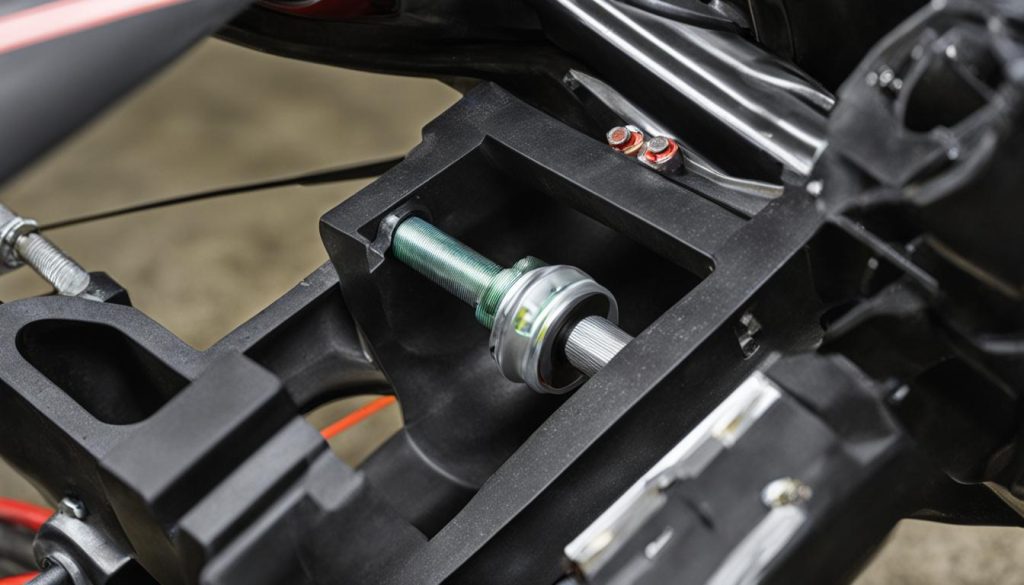
- Next, lift the differential housing until the weight of the car is on the leaf springs. This step ensures accurate adjustment.
- Adjust the snubber to create a small gap, approximately 1/2 inch, between the snubber and the leaf spring. This gap allows for proper cushioning and prevents excessive contact.
- To maintain the desired clearance gap, use shims or wedges under the axle U-bolts and mounting plates. These adjustments will help fine-tune the performance of your traction bars.
Proper snubber and clearance adjustment are critical for achieving optimal traction and stability. By following these steps, you’ll ensure that your traction bars function effectively and provide the desired performance benefits for your vehicle.
Final Installation Steps
After adjusting the snubber and ensuring the proper clearance, it’s time to complete the installation of leaf spring traction bars. Follow these final steps:
- Reinstall the rear shock absorbers and tighten them firmly.
- Lower the vehicle and reinstall the rear tires.
- Install the front U-bolts, ensuring they contact the top of the leaf spring with the snubber gap still at the desired distance.
- Secure all nuts and bolts, double-checking for any interference or contact with other components.
With these final installation steps, your leaf spring traction bars are now properly installed, helping to improve traction and stability during your drives.
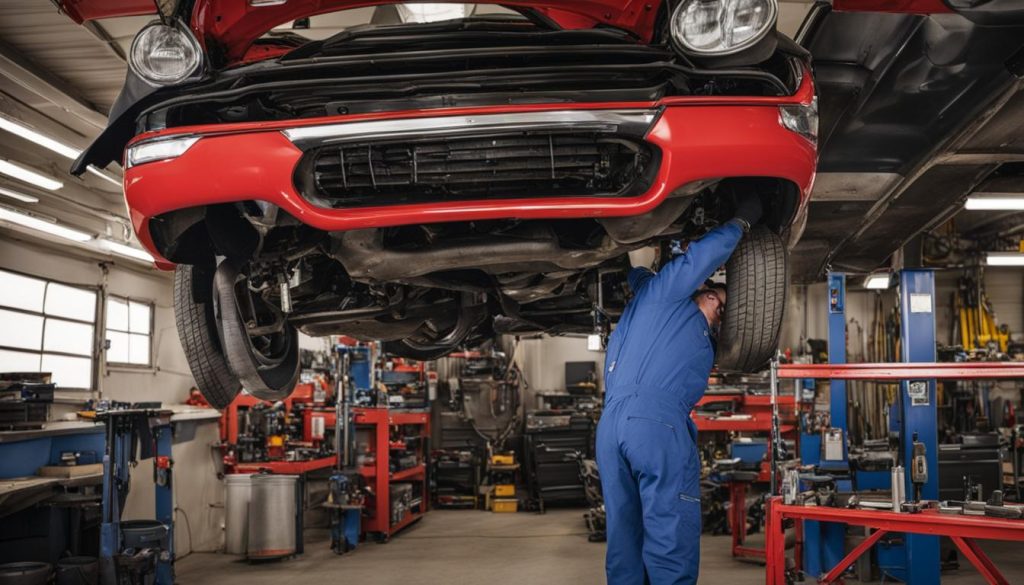
Benefits of Proper Installation
Completing the installation of traction bars on leaf springs offers several advantages for your vehicle:
| Benefits | Description |
|---|---|
| Improved Traction | Prevent spring wrap-up and wheelhop, keeping your tires planted on the ground. |
| Enhanced Stability | Stabilize the leaf springs, reducing side-to-side motion and improving overall driving stability. |
| Reduced Axle Wrap | Minimize axle rotation under acceleration, reducing stress on the drivetrain components. |
| Increased Performance | Enjoy better control and handling, especially during high-performance driving and towing situations. |
Tuning Tips and Recommendations
To optimize the performance of your traction bars, consider these tuning tips and recommendations:
- Avoid using the square U-bolts to adjust the height of the bar, as it can lead to excessive pre-loading and undesirable effects on the suspension.
- Ensure that rear tire pressures are equal for consistent traction.
- Avoid using air shocks for drag racing applications.
- Experiment with the snubber gap to fine-tune performance based on your vehicle’s characteristics.
- Consider pre-loading the suspension for competition vehicles, but maintain a 3/8 inch gap on street/strip vehicles for a better ride.
By following these tips, you can optimize the performance of your leaf spring traction bars and achieve improved traction and stability.
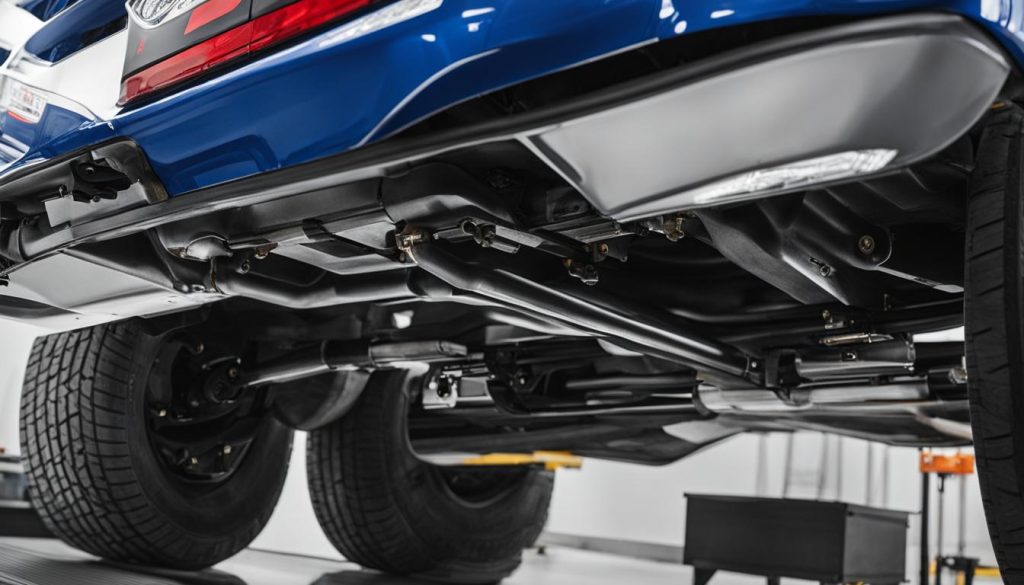
Conclusion
Installing leaf spring traction bars on your vehicle can make a significant difference in its performance. By following the step-by-step instructions and implementing the tuning tips outlined in this guide, you can enhance traction, stability, and overall driving experience. Improved traction means better acceleration and control, especially during powerful launches or high torque situations.
Ensuring the proper installation of your leaf spring traction bars is essential for optimal results. By carefully positioning and aligning the traction bars, adjusting the snubber and clearance, and securing all nuts and bolts, you can minimize wheelhop, prevent spring wrap-up, and maintain tire contact with the road surface.
Always prioritize safety throughout the installation process and consult professional help if needed. It is crucial to have all the necessary tools and components, follow the guidelines provided by the manufacturer, and double-check for any interferences or contact with other components. Once installed, regularly monitor and fine-tune the performance of your traction bars to suit your vehicle’s characteristics and personal preferences.
In conclusion, the installation of leaf spring traction bars can greatly enhance the performance and drivability of your vehicle. By following our comprehensive guide and taking into account necessary safety measures and tuning considerations, you can enjoy a smoother, more controlled ride, improved traction, and increased stability in various driving conditions.
FAQ
What are the benefits of installing traction bars on leaf springs?
Installing traction bars on leaf springs can greatly enhance your vehicle’s performance by preventing spring wrap-up and limiting wheelhop. This helps keep your tires planted on the ground, resulting in improved traction and stability.
What tools and materials do I need to install traction bars on leaf springs?
To install traction bars on leaf springs, you will need safety jack stands, U-bolts and mounting brackets, a rubber snubber, a hacksaw (for adjusting the snubber), shims (for adjusting the bar angle), and wrenches and sockets.
How do I prepare for the installation and ensure my safety?
Before installing the traction bars, lift the rear of the vehicle using a jack, place safety jack stands under the rear end, and ensure adequate clearance for all suspension components.
How do I position and align the traction bars?
Position the traction bar under the leaf spring, center the traction bar mounting pad under the axle and U-bolts, and adjust the bar angle using shims to ensure the snubber end is angled up parallel to the chassis.
How do I adjust the snubber and maintain the proper clearance?
Install the rubber snubber, lift the differential housing until the weight of the car is on the leaf springs, and adjust the snubber to create a small gap (approximately 1/2 inch) between the snubber and the leaf spring. Use shims or wedges to maintain the desired clearance gap.
What are the final steps for completing the installation of traction bars on leaf springs?
Reinstall the rear shock absorbers, lower the vehicle, reinstall the rear tires, install the front U-bolts, and secure all nuts and bolts, double-checking for any interference or contact with other components.
What tuning tips and recommendations should I consider?
To optimize the performance of your traction bars, avoid using the square U-bolts to adjust the bar height, ensure equal rear tire pressures, avoid using air shocks for drag racing applications, experiment with the snubber gap for fine-tuning, and consider pre-loading the suspension for competition vehicles.
What are the final thoughts on leaf spring traction bar installation?
Installing traction bars on leaf springs can greatly improve traction, stability, and overall performance. By following the step-by-step instructions provided and considering the tuning tips, you can successfully install traction bars and enjoy a smoother and more controlled ride.

